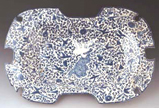|
Hispano-Muslim
conventions were often combined with motifs and surface decoration
of European, Chinese, and even native Mexican origins to create
a distinctive Puebla style.
|
| Function |
This
seventeenth century platter was used in everyday life
for food as well as decoration.
|
| Technique
or Process |
The
shape of this platter is derived from Baroque silverware.
The lavish use of cobalt blue on this platter is extraordinary
considering its value at the time. There are no known
sources for cobalt in or near Mexico. Puebla workshops
probably purchased cobalt imported from Spain, where it
had been sent from the Middle East or North Africa in
cake form.4 It is also possible that it was imported from
China.
|
| Cultural
Roots |
Among
the Hispano-Muslim decorative conventions that have influenced
Puebla potters during the seventeenth century, the horror
vacui (fear of empty spaces) was perhaps the most important.
The affinity for decorating the entire surface of a vessel
with small dots is typical of this aesthetic. In the 1682
amendment to the 1653 issuance of the potteršs ordinances,
the first clause specifies the use of aborronado (blurred
dot) decoration in blue, which is visible in this platter.
|
| Lesson
Plans |
|
| Extension
Activities |
Social
studies: Where the different motifs originated
Science: Location of cobalt and how it might have
made its way to Mexico
|
|

